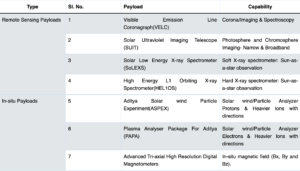ForumIAS announcing GS Foundation Program for UPSC CSE 2025-26 from 27th May. Click Here for more information.
Contents
Source: The post is based on the article “ISRO’s Aditya-L1 to be launched on September 2: With feet on the Moon, the space agency eyes the Sun” published in Indian Express on 29th August 2023
What is the News?
ISRO has announced that the Aditya-L1 mission will be launched on September 2 from Sriharikota, Andhra Pradesh.
What is Aditya-L1 Mission?
Aditya-L1 is the first Indian mission dedicated to observe the Sun.It is scheduled to be launched aboard a Polar Satellite Launch Vehicle(PSLV).
Objectives of the Mission: Study of Solar upper atmospheric (chromosphere and corona) dynamics.
– Study of chromospheric and coronal heating, physics of the partially ionized plasma, initiation of the coronal mass ejections and flares
– Observe the in-situ particle and plasma environment providing data for the study of particle dynamics from the Sun.
– Physics of solar corona and its heating mechanism.
– Development, dynamics and origin of coronal mass ejection (CME).
– Magnetic field topology and magnetic field measurements in the solar corona .
Lagrange Point: There are five Lagrange points, L1 to L5, between any two celestial bodies. These points can act as parking spots in space where the gravitational pull of the celestial objects equals the centripetal force required to keep a satellite in orbit.
– This means satellites placed at Lagrange points do not need to expend a lot of fuel to remain in position.
– Aditya L1 shall be placed at L1.A satellite placed in the halo orbit around the L1 point has the major advantage of continuously viewing the Sun without any occultation/eclipses.
– This will provide a greater advantage of observing the solar activities and its effect on space weather in real time.
What are the payloads of Aditya L1 Mission?
The spacecraft carries seven payloads to observe the photosphere, chromosphere and the outermost layers of the Sun (the corona) using electromagnetic and particle and magnetic field detectors.
Source: ISRO
Why should we study the Sun?
Firstly, the Sun is our closest star, allowing for detailed examination.This research not only enhances our knowledge of the Sun but also sheds light on other stars.
Secondly, while the Sun sustains life on Earth, it also produces explosive events that can harm satellites and communication systems.Monitoring the Sun can offer early warnings for such disruptions.
Thirdly, the Sun exhibits extreme thermal and magnetic phenomena that serve as a natural laboratory for scientific exploration.These phenomena can’t be adequately studied in a controlled lab environment.
Lastly, it is important to study the Sun from space because the Earth’s atmosphere and the magnetic field act as protective shields that block out harmful radiations, such as UV light.This means studying the Sun from the Earth can’t provide a complete picture.





